
* The acceleration of efforts to explore the Moon in the 21st century in the late 20-teens, largely through an "X-Prize" competition for a commercial Moon lander. The competition was ultimately abandoned, but along the way it led to a frenzy of Moon missions by government agencies and commercial startups.
* An ISRO Geostationary Satellite Launch Vehicle (GSLV) booster was launched from Sriharikota on 22 July 2019 to send India's second lunar mission, "Chandrayaan 2", to the Moon. The probe included an orbiter, lander, and rover:
Vikram and Pragyan were designed to operate for one lunar day, or about two weeks, but were not intended to survive the lunar night. After launch, Chandrayaan 2 used a slow outward spiral trajectory to get the Moon, performing a series of burns to progressively raise its apogee, to finally perform a landing a month after launch. However, apparently the lander crashed, contact being lost. The orbiter was still operational at last notice.
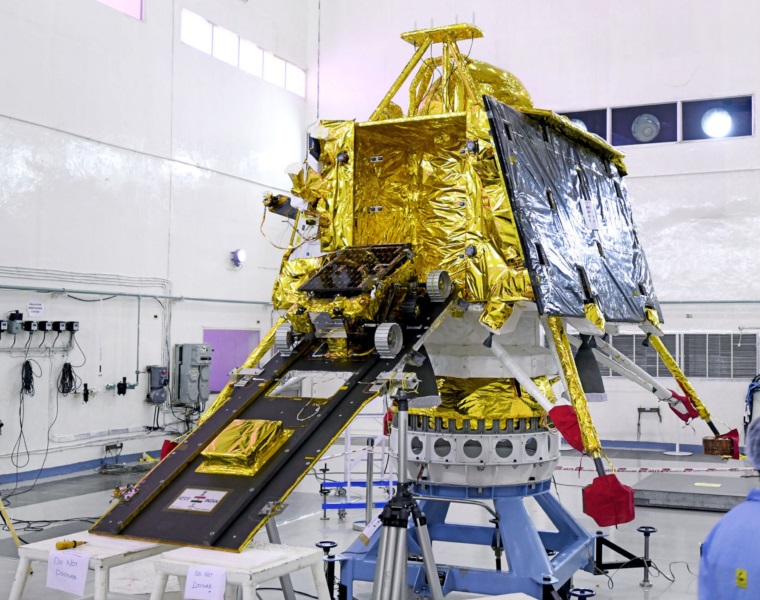
* The Chinese continued their Moon missions in response, with a Long March 5 booster launched on 23 November 2020 from the Wenchang space center on Hainan Island to send the "Chang'e 5" lunar sample-return probe to the Moon. It was the first lunar sample-return mission since 1976.
The Chang'e 5 lander touched down on 1 December in the Oceanus Procellarum (Ocean of Storms) region in the northern hemisphere of the near side of the Moon. It took samples, drilling as deep as 2 meters. The samples were launched back up to the Chang'e 5 return vehicle in lunar orbit on 3 December. The return vehicle left lunar orbit on 13 December, to drop its sample-return capsule on 16 December. The lander was not designed to and did not survive the lunar night.
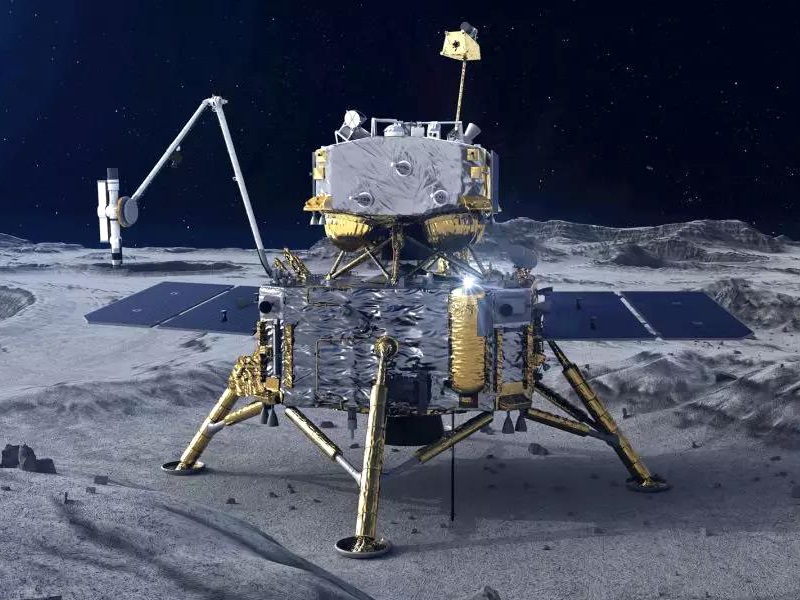
The sample-return capsule had been tested in a 2014 launch, being sent around the Moon and back to Earth in 2014 to ensure that it worked properly. The Chinese are working on a similar "Chang'e 6" sample-return mission, which will return samples from the lunar farside. Unlike Chang'e 5, which was an all-Chinese mission, the Chang'e 6 spacecraft will carry foreign instruments. The French space agency, CNES, announced in 2019 that it will provide an instrument for the Chang'e 6 mission to study the Moon's exosphere and water cycle.
BACK_TO_TOP* New Moon missions appear to be on a growth path, boosted by a push towards space commercialization. From the beginning of the century, A number of startups to promote commercial missions to the Moon, funded by corporate and private sponsors and sales of imagery. One company, Transorbital, did manage to launch a dummy spacecraft of their "Trailblazer" Moon orbiter on a Russian Dnepr booster in 2002, but the effort went into limbo after that.
These efforts were plagued by funding difficulties; from 2007, search engine giant Google and the X-Prize Foundation, which sponsors commercial space competitions, did offer a $20 million USD prize to the first private company to successfully send a rover to the Moon. A number of startups worked on the effort -- but the deadline kept slipping out, and the competition was finally canceled in early 2018. However, it did help set up an international network of commercial space companies focused on lunar exploration.
The first commercial Moon probe was the Israeli "SpaceIL Lunar Lander" or "Beresheet", launched by a SpaceX Falcon 9 booster as a secondary payload on 22 February 2019. SpaceIL was one of the commercial operations set up in response to the Lunar X-Prize. The name "Beresheet" meant "Genesis", in reference to the Book of Genesis: "In the beginning ..."
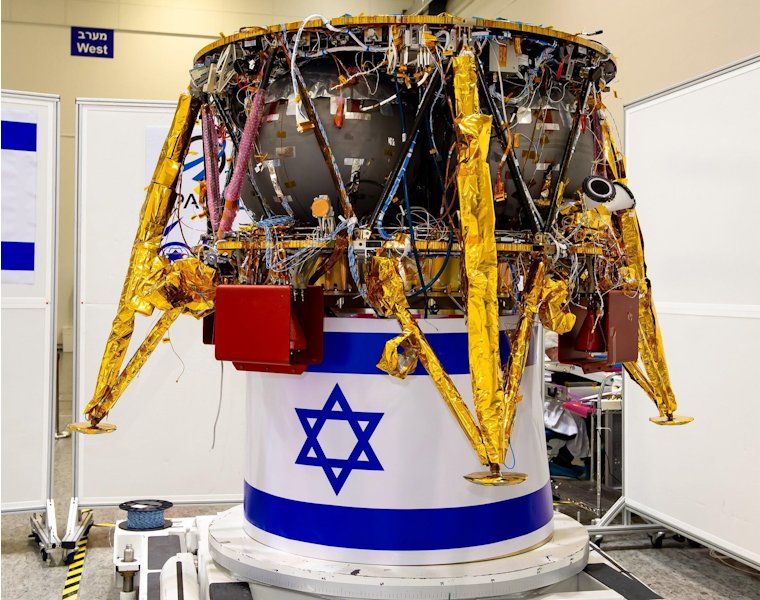
The lander was built by Israel Aerospace Industries and had a launch mass of 600 kilograms. Its payload suite included a magnetometer, cameras, and a laser retroreflector. It also carried a time capsule with the Israeli flag, plus digital copies of the Israeli national anthem, the Bible, and other national and cultural artifacts. The lander was battery-operated, and was to only function for two days. As a secondary payload, it was put into Earth orbit, and had to use its propulsion system to get it gradually to the Moon. It finally reached Moon orbit on 4 April 2019, to attempt a landing a week later. It crashed.
In the meantime, NASA decided to encourage startups working on Moon probes by setting up the "Commercial Lunar Payload Services (CLPS)" program to fund their activities. It clearly had a debt to the X-Prize contest, with NASA providing funds for lunar missions to space startups, with CLPS also focusing on related low-cost technologies such as compact instruments.
The NASA CLPS was seen as complementary to the "Artemis" program, a crewed lunar exploration program led by NASA, with collaborators including the ESA, JAXA, and other space agencies. Artemis was initiated in 2017, though it was an evolution of other programs dating to 2005. It envisioned four elements:
The first CLPS mission was NASA's "Cislunar Autonomous Positioning System Technology Operations & Navigation Experiment (CAPSTONE)" lunar orbiter. It was launched on 28 June 2022 on a Rocket Labs Electron light booster, flying from the Rocket Labs launch center on the Mahia Peninsula of New Zealand's North Island.
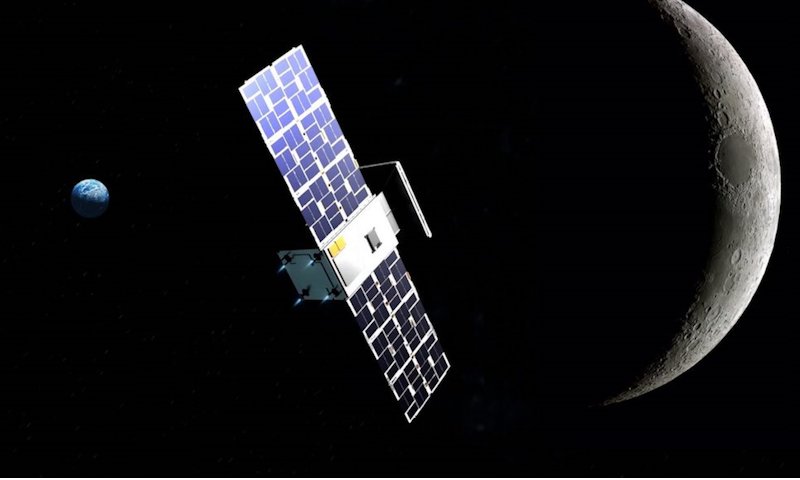
CAPSTONE was a 12-unit (12U) "CubeSat" -- the CubeSat being a tiny satellite standard, the basic unit being a cube 10 centimeters on a side. CAPSTONE had a launch mass of 25 kilograms. It was sent on a low-energy trajectory and took four months to reach the Moon, being placed in the elliptical Moon orbit to be used by the Lunar Gateway space station, to be used to test deep space navigation and communications for the Gateway. It was still operational at last notice.
* In parallel with NASA efforts, a number of other space agencies were working on Moon shots. On 4 August 2022, a SpaceX Falcon 9 booster was launched from Cape Canaveral to send the "Korea Pathfinder Lunar Orbiter (KPLO)" AKA "Danuri" to the Moon on behalf of the Korean Aerospace Research Industry (KARI). It was the first Korean mission beyond Earth orbit. The probe had a launch mass of 678 kilograms and carried five instruments:
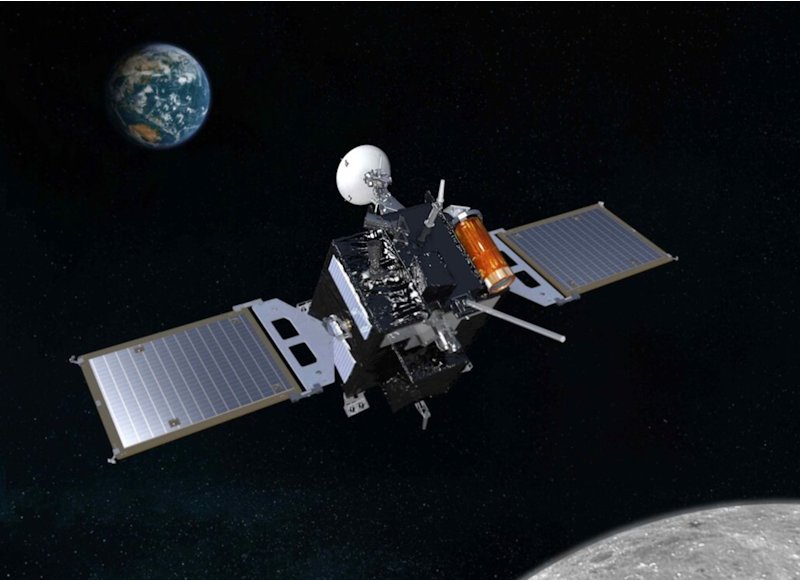
It also carried a test payload for a datalink system. The probe went into lunar orbit on 16 December 2022. The mission was intended to examine permanently shadowed craters for signs of water ice, measure the composition of lunar regolith, and capture high-resolution images to map future landing sites. The probe was still in service at last notice.
BACK_TO_TOP* The first "all-up" Artemis mission was launched from Cape Canaveral on 16 November 2022, with the "Artemis I" flight carrying an uncrewed Orion space capsule on an extended Earth orbit around the Moon, with two lunar flybys. For this mission, it carried three mannequins. The mission also included ten 6U CubeSats, including:
* Less than a month later, on 11 December 2022, a SpaceX Falcon booster was launched from Cape Canaveral to send the "Hakuto R" lander to the Moon. "Hakuto" means "White Rabbit" in Japanese; it was a privately-funded mission by the ispace firm of Japan, which was an outgrowth of the X-Prize competition. The lander was built at ArianeGroup GMBh's facility in Lampoldshausen, Germany. It had a launch mass of about 1,000 kilograms. The lander also carried:
The flight also included a Moon-orbiting CubeSat from NASA's Jet Propulsion Laboratory named "Lunar Flashlight", which was to have a highly elliptical orbit that would take it close to the Moon's surface, to hunt for ice with a laser sensor.
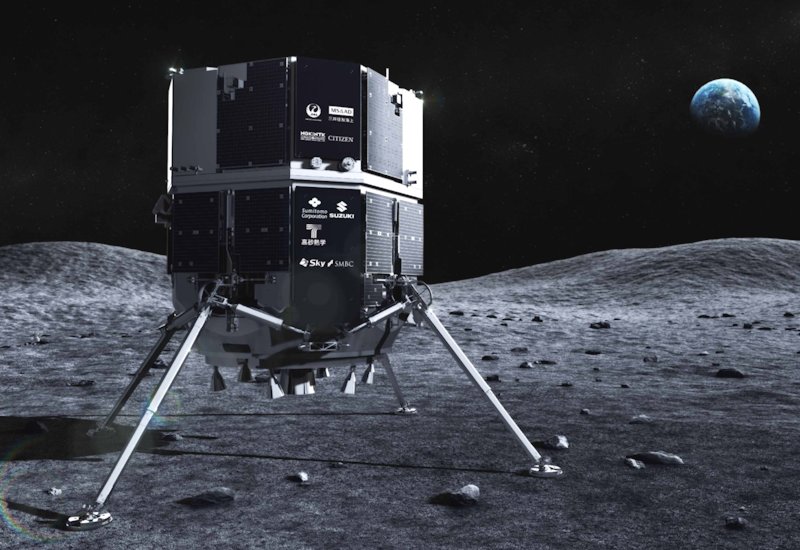
The mission was a failure, the lander crashing on its landing attempt in April. The Lunar Flashlight orbiter failed to enter orbit around the Moon and was written off.
* The following summer, on 14 July 2023, an ISRO GSLV booster was launched from Sriharikota to send the "Chandrayaan 3" probe to the Moon. It was similar to Chandrayaan 2, with a Vikram lander and Pragyan rover, both with some refinements, but had a "propulsion module" instead of an orbiter with a science payload. The propulsion module had a mass of 2,148 kilograms; it carried Vikram to the Moon, then served as a communications relay in lunar orbit.
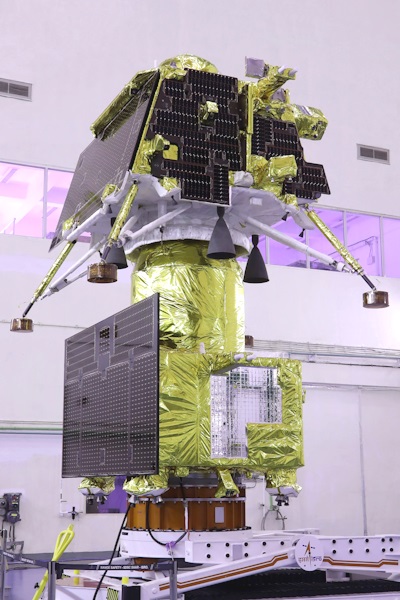
Vikram successfully landed on the Moon on 23 August. The landing site was in the Moon's south polar region, where it was to hunt for signs of water ice. It was the first successful Moon landing in a polar region. The planned mission lifetime was only two weeks; it lasted twice that long.
BACK_TO_TOP* Only a few weeks later, on 10 August 2023, a Russian Soyuz 2-1b booster was launched from the Vostochny space center to send the "Luna 25" lander probe to the Moon. It had been preceded by the Soviet Luna 24 lander in 1976, and had been in planning for decades. The Luna 25 lander had a launch mass of 1,750 kilograms, and was to land near the Moon's south pole. The lander crashed. The exercise proved a demonstration of the decline of the Russian space program, which promised to sink into oblivion as the country approached a state of overall breakdown.
* Following that, on 6 September 2023 a JAXA H2A booster lifted off from the Tanegashima launch center, carrying the "X-Ray Imaging & Spectroscopy Mission (XRISM)" X-ray telescope as a primary payload, along with the "Smart Lander for Investigating Moon (SLIM)" lunar lander.
XRISM was the primary payload and is not mentioned further here. The SLIM lander was Japan's third attempt to land on the Moon, following the failure of the Hakuto R and Omotenashi missions. The SLIM lander had a launch mass of 700 kilograms. It featured twin main engines, powered by storable propellants, along with 12 control thrusters.
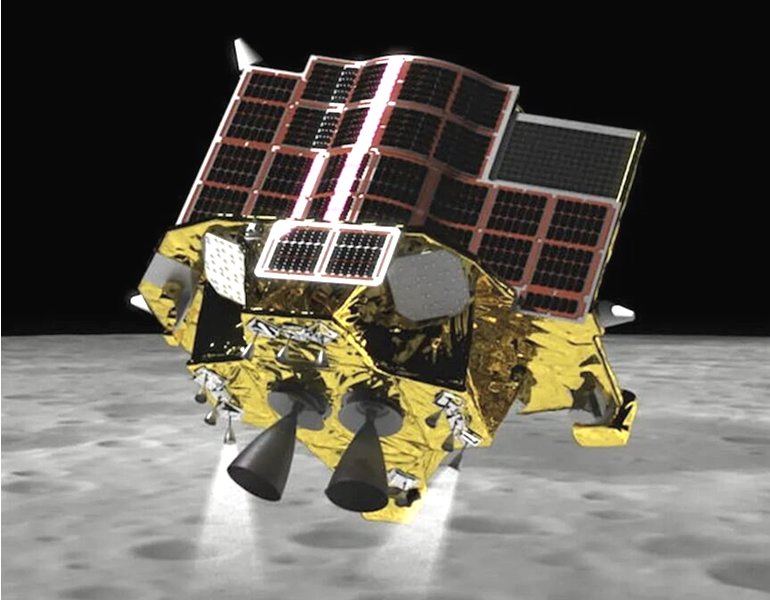
SLIM spent four months getting to the Moon, then spent a month in orbital checkout. It landed in Mare Nectaris, under the direction of a landing radar, laser range finder, and a navigation camera. One of the major goals of the mission was to test out the precision navigation. It had five fixed landing legs with crushable "one-shot" shock absorbers. Thin film solar panels on the probe provided power, while an S-band communication system connected SLIM with Earth. The probe carried a multi-band spectral camera designed to measure the composition of rocks surrounding the landing site.
A small probe known as the "Lunar Exploration Vehicle (LEV) 1" separated from SLIM just before landing to image the site. SLIM also carried the ball-shaped "Sora Q" mini-rover AKA "Lunar Exploration Vehicle (LEV) 2", designed by Tomy, the Japanese toy maker who invented the transformers toys. One had also been carried by the unsuccessful Hakuto R lander. In addition, NASA provided yet another a laser retroreflector.
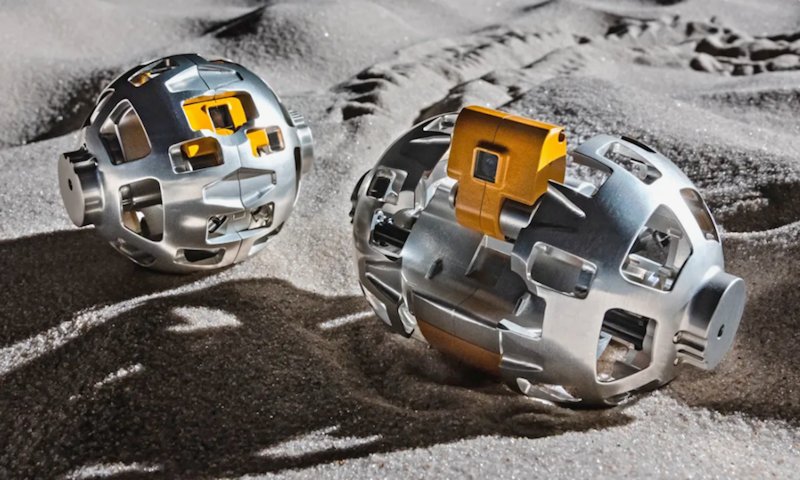
* Moon missions are going at a fair clip these days, and it's a good bet that will continue. The NASA CLPS program appears to be moving along, but has suffered from delays, with some of the participants dropping out. That could be expected with a program generally based on small startup companies, many of which fail. However, it does make future plans opaque, so it's best to take a "wait & see" mindset to find out which missions actually fly, and when.
As far as the Artemis program goes, it's also not entirely nailed down. Over the longer term, there's been considerable thought of using the Orion capsule to support "hybrid" missions, with astronauts using telerobotics to work on the Moon's surface, without landing themselves. Robot systems would be landed on the Moon, with an Orion sent into orbit around the Moon, along with a set of small comsats to maintain the communications link to the robots. While teleoperated robots could be run from Earth, the delay of a few seconds would make it troublesome. The astronauts would be isolated from the Moon's environment in spacesuits if they landed; it is hard to think of much distinction between exploring in spacesuits, or exploring via teleoperated robots -- except that the robotic option would be cheaper, and the robots would not have to be recovered. Indeed, more robots could be landed to build up a Moon base.
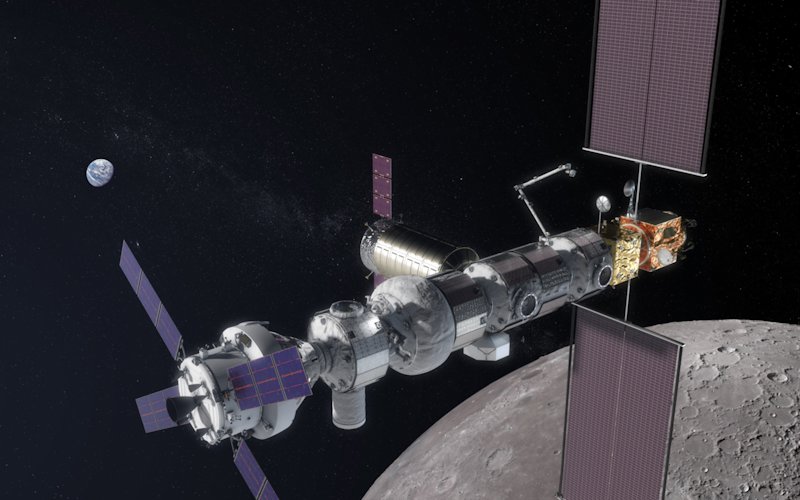
One particularly interesting mission based on telerobotics would be assembly of a radio telescope on the lunar farside, where it would be shielded from Earthly radio interference. In one scenario, three astronauts would ride an Orion capsule to the Earth-Moon libration point, 64,000 kilometers above the farside. They would use teleoperated robots to set up the radio telescope, rolling out 10-meter plastic sheets studded with antennas.
The concept remains purely speculative. Stanley Kubrick's 1968 sci-fi movie 2001: A SPACE ODYSSEY envisioned a city-sized base on the Moon; of course, 2001 came and went, with nothing of the sort having happened. Indeed, will there be any such Moon base in 2101? However interesting the Moon is as a subject of study, is there any compelling reason to spend enormous sums to set up a colony there? Possibly there may be in the future -- but nobody could propose one now.
BACK_TO_TOP* In almost every source with any detail on the Moon, there's a discussion of why it looks bigger closer to the horizon than it does directly overhead. I didn't include that discussion here for the simple reason that I've never noticed that it does, even when I've tried. It certainly looks more vivid closer to the horizon, but it never occurred to me to think that it looked bigger.
As another footnote, in 2002 astronomers spotted what appeared to be a tiny "moonlet" of the Earth, at a distance about twice that of the Moon proper. The object, cataloged as J002E3, was later determined to be spacecraft debris, apparently the third stage of the Saturn V booster that launched the Apollo 12 mission in 1969. It was in orbit around the Sun, but it was finally captured by the Earth's gravity. The orbit is highly elliptical, and the object is expected to either crash into the Moon, or fall into the Earth's atmosphere and burn up.

* Sources include:
Of course, a number of websites were consulted as well as print sources. One of the most important was Bill Arnett's excellent "A Multimedia Tour Of The Solar System", which is not only readable and thorough in itself, but provides an extensive set of links for investigation down to excruciating detail. The NASA, ESA, and JAXA websites were also consulted.
* Illustrations credits:
* From 2000 to 2002, I wrote a series of documents on planetary exploration, and then consolidated them in 2002 into a unified document, THE EXPLORATION OF THE PLANETS. It turned out to be too big and hard to maintain, so from 2021 I broke in down into components again.
* Revision history:
v3.0.0 / 01 nov 21 / Update of stand-alone document. v4.0.0 / 01 dec 23 / Updated, went from two to three chapters.BACK_TO_TOP
